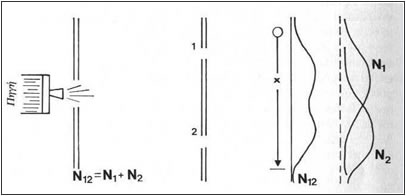
You are here: Home >> History of Light >> The two-slits experiment >> Light as particles
 The following image shows a source of balls and after that there is a slit. After a while there are two more slits (slit Νο 1 and slit Νο 2. Balls can pass through the slits. Behind the slits there is a detector, which counts the number of balls falling into it, where x is the distance of the detector from a still point (see figure).
The following image shows a source of balls and after that there is a slit. After a while there are two more slits (slit Νο 1 and slit Νο 2. Balls can pass through the slits. Behind the slits there is a detector, which counts the number of balls falling into it, where x is the distance of the detector from a still point (see figure).
We start firing balls and we measure the number of them passed through the slits after an hour. We call this number arriving probability. After one hour we see a curve which represent the number of balls reached the detector. We call this curve Ν12. The curve reveals that the number of balls reached the detector is higher in the area behind the two slits.
What we should take into accountOf course it is impossible for anyone to think that a ball pass through the first slit and then changes its direction in order to pass through the second slit. However we must make this assumption. Otherwise we will never make it to come closer to the things work. However if we accept the fact that a ball can change its direction, it seems normal to take the curve Ν12.
Let us see for a while what exactly represents the curve Ν12. We could say that it the result of the interference of the curves Ν1 and Ν2.
The curve Ν1 shows the number of balls which are detected when we remove slit Νο2, so all balls have to pass through slit No1. The curve Ν2 represents the same number when slit No1 has been removed and all balls have to pass through the slit No2. After all we conclude that: The number of balls which pass through the two slits is the sum of the number of balls which pass through slit No1 and No2.
N12=N1+N2